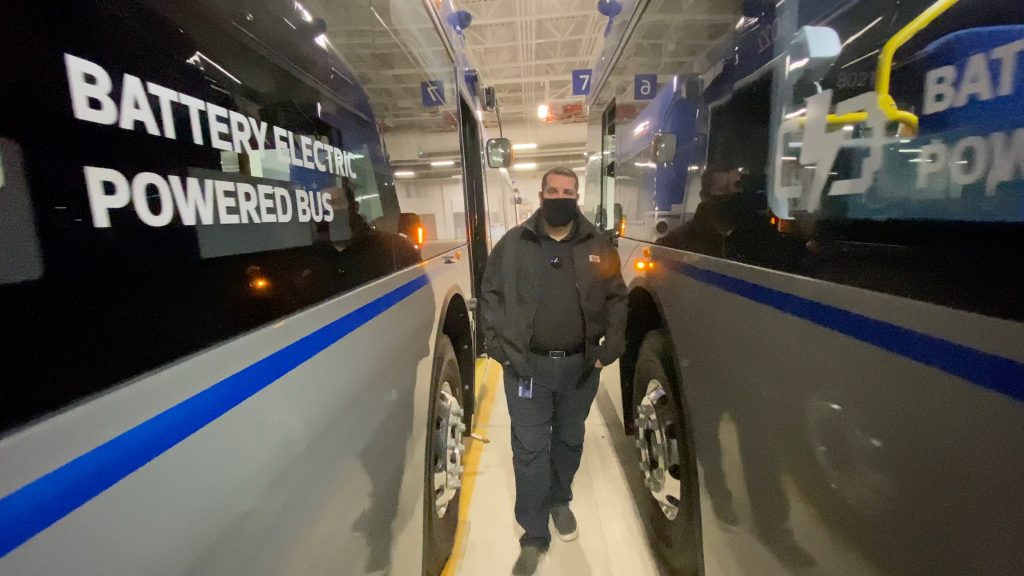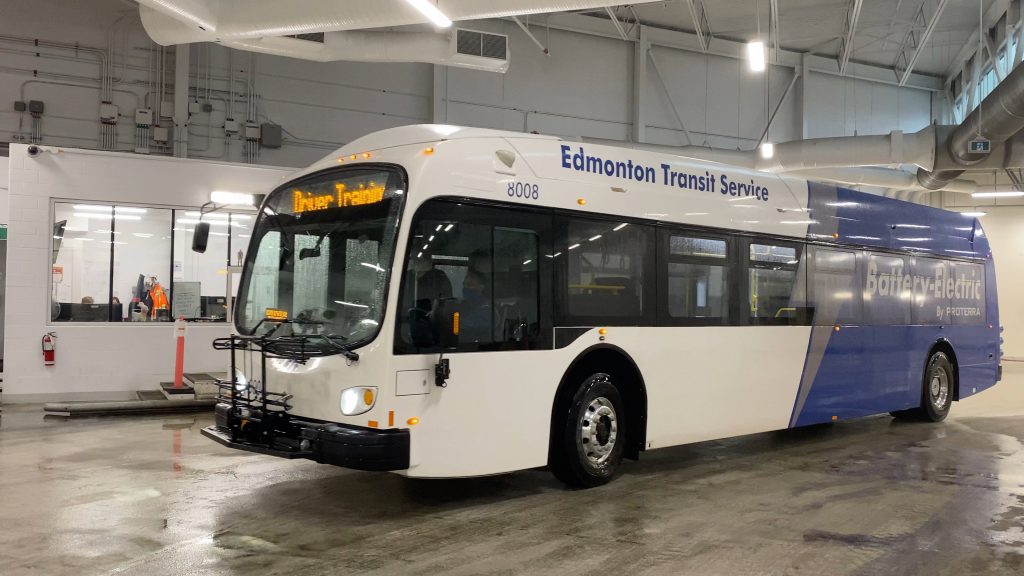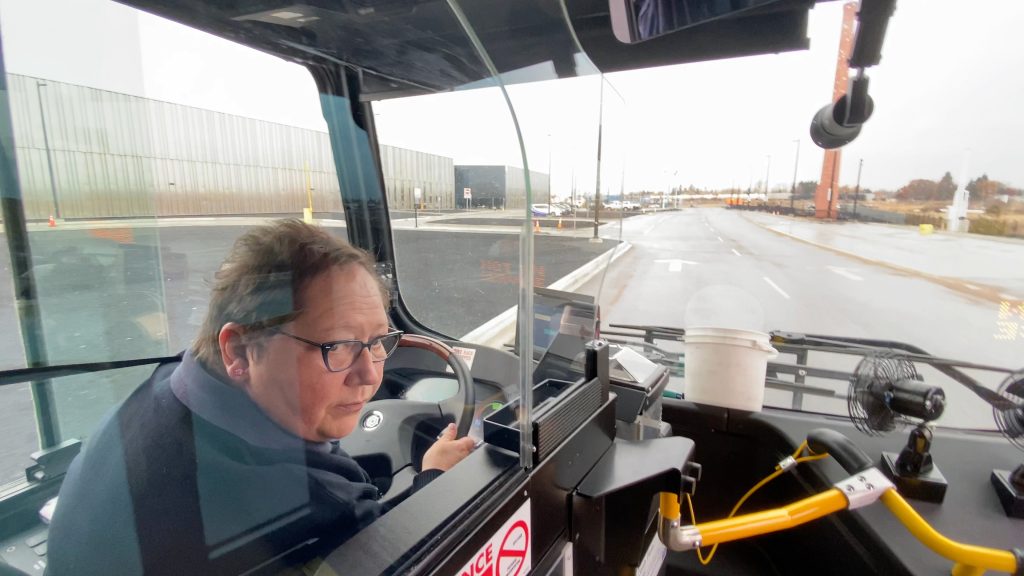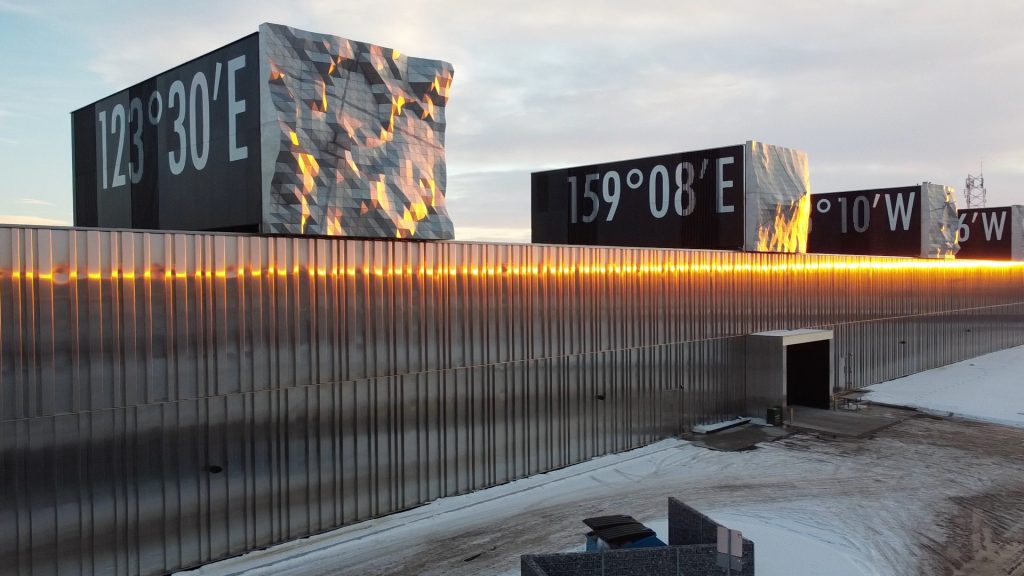UPDATE Mar. 8, 2024 – Last summer Proterra the U.S. manufacturer of electric buses filed for Chapter 11 bankruptcy protection. The CBC reports “The city’s U.S. lawyers wrote that Edmonton’s electric buses have failed to meet contract qualifications with respect to range, battery life, reliability and durability.”
As many as half of Edmonton’s electric buses were sidelined while they waited for replacement parts.
Representatives of Edmonton Transit told the City’s Energy Transition and Climate Resilience Advisory Committee on Mar. 7, 2024, that they are still committed to zero emissions goals and already have a new net-zero garage in the works. But in the interim, the City intends to purchase 20 diesel buses while they reevaluate their strategy. The City has one hydrogen bus and is exploring the possibility of using hydrogen buses. But they also are not ruling out a return to electric buses at some point. It’s a blow to the City’s goal of eliminating transportation emissions which amount to about one-third of the City’s total emissions.
ORIGINAL STORY
By David Dodge and Kay Rollans
Edmonton has quietly become a national leader in electric buses and, contrary to what you might, think these new zero-emissions vehicles could result in dramatically lower operating costs.
Edmonton has 33 electric buses in service already, silently plying their way through routes across Edmonton. Another seven buses are due for imminent delivery.
“We’re able to take 60 electric buses in our fleet at any one time and our fleet size right now is just under a thousand buses,” says Eddie Robar of Edmonton Transit. “This enables us to look at what the transition of the future looks like.”
That transition Robar is talking about is from a diesel-based transit system to electric—and it’s Robar’s job to oversee the transformation.
Robar’s team very carefully researched several different electric bus options. Robar himself even visited Shenzhen, China, a city the size of New York with an entirely electric bus system—a fleet of over 16,000 buses. He learned some valuable lessons there. One is the focus on long-range buses. You can buy a few cheaper short-range buses and check off the electric bus box, but then you need chargers in the field and the electric buses are limited in their application.
Robar is pretty jazzed about his first 40 e-buses, especially now that he’s had time to work with them and confirm some of his expectations.
YEG e-bus photo gallery
50 to 75 per cent savings on fuel cost
Edmonton purchased 40 electric buses from a single supplier: Proterra. The buses are manufactured in California.
“We chose this bus specifically because of its range. The range of this bus gets us about 350 kilometres, which means it can do almost every piece of work that we have in our system,” says Robar.
“We’re seeing better than what we anticipated for distance on these vehicles. It goes out for a 14-hour shift and comes back with a 65 to 70 per cent state of charge,” says Robar.
Sourcing buses from a single supplier also allows Edmonton Transit to work with a single type of charging infrastructure, avoiding challenges currently faced by North America’s largest e-bus fleet in Toronto.


Edmonton chose an overhead pantograph high-speed charging system. This saves precious space in the garage and it means Edmonton Transit only needs 22 chargers for their 40-bus fleet.
It only takes three hours to fully charge an empty bus battery. With buses coming back with 65 to 70 per cent of battery capacity remaining, however, Robar says it’s only taking an average of an hour a day to charge each bus.
Electrification is a cornerstone of Edmonton’s municipal Energy Transition Strategy, which seeks to reduce greenhouse gas emissions and stay within the 1.5-degree Celsius carbon budget sought by the Paris Climate Accord.

But for Robar, it’s also about “keeping our costs low”—and reducing operating costs is one of the most important things in municipal budgeting.
Like all things electric, the upfront costs tend to be higher. In the long run, though, Robar says “this offers us a 30 per cent reduction in costs for maintaining the bus … And on top of that, anywhere from 50 to 75 percent savings in our fuel.”
Electric engines have muscle and durability
These days, anyone who’s had some experience with modern electric vehicles will tell you that they are some of the fastest, most powerful vehicles on the road.
But Robar’s team ran some tests just to make sure.

“We put 15 thousand pounds of sandbags [in a Proterra e-bus], stopped on the steepest hill in Edmonton, and then took off from a dead start,” says Robar, adding, with a hint of a smile visible beneath his mask, that the bus “just hauled.”
Once charged, these electric e-bus batteries deliver top-notch performance, rain or shine—or deep-freeze temperatures. Edmonton being the most northerly major city in the Western hemisphere, you’d better believe Robar’s team did their homework on batteries and cold weather performance.
The battery packs “have a glycol solution that runs around them and keeps them at a 24-degree [Celsius] level, no matter if it’s 50 degrees below zero,” says Robar. This means the batteries are never cold and—unlike your cellphone—won’t suffer the power-draining effects of cold weather.
Edmonton Transit also found that battery performance suffers in the winter simply because passengers need to be kept warm. Robar’s team solved this problem by installing gas heaters in the e-buses for those really cold days, to take some pressure of the batteries.
The batteries are designed to work for a dozen years, but just to be safe, Robar’s team negotiated a 6-year swap out option with Proterra to ensure Edmonton buses won’t suffer any battery degradation issues.

“A super supportive mayor”
Robar says the electric bus program grew out of a “first-day conversation” with Edmonton’s Mayor Don Iveson about “what it would be like to have electric buses in place … I think we’re really fortunate to have not only a supportive council, but a super supportive mayor.”
The first electric bus hit the streets of Edmonton in early 2020. Now, with nine months’ experience under their belts, Robar thinks they are learning what they need to know to create “plans in the future to fully electrify our fleet.”
“We get great benefits from the GHG side. We get great benefits from the maintenance, and we also get that operational savings every single year.”
The best part of all is that these new electric buses, with their long range, can be seamlessly incorporated into Edmonton’s current transit system. Whether diesel or electric, Robar says that in Edmonton, “a bus is a bus is a bus.”
Tune in next week for Part 2, as we look at the (literally) shiny, new Kathleen Andrews Transit Garage essential infrastructure supporting Edmonton’s electric transit transition.
UPDATE June 3, 2021 – In June 2021 Edmonton secured 20 more electric buses bringing the total to 60 due to support from the Canada Infrastructure Bank.
“The success of our economy, public health, and quality of life all depend on Edmonton making a shift to a low carbon future which is why this investment by the Canada Infrastructure Bank is so crucial. In addition to supporting our economic recovery, this investment in zero-emission public transit and greener buildings helps ensure Edmonton is making tangible gains in its goal to become a competitive, low-carbon City of the future,” says Mayor Don Iveson in the announcement.













